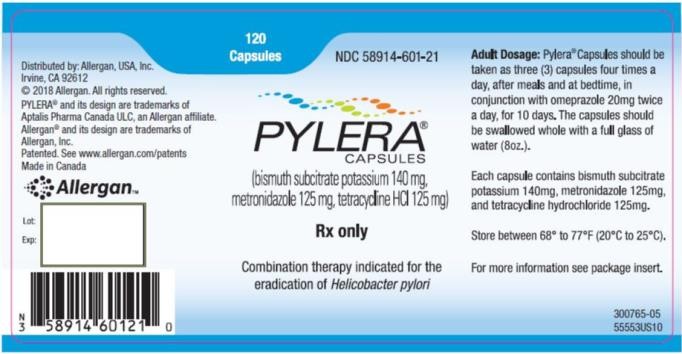
Contents
- 1 Pylera
- 1.0.1 Warnings
- 1.0.2 What are the side effects of Pylera?
- 1.0.3 What is the dosage for Pylera?
- 1.0.4 What drugs interact with Pylera?
- 1.0.4.1 Methoxyflurane
- 1.0.4.2 Disulfiram
- 1.0.4.3 Alcohol
- 1.0.4.4 Oral Contraceptives
- 1.0.4.5 Anticoagulants
- 1.0.4.6 Lithium
- 1.0.4.7 Antacids, Multivitamins, or Dairy Products
- 1.0.4.8 Busulfan
- 1.0.4.9 Inhibitors of CYP450 Liver Enzymes
- 1.0.4.10 Inducers of CYP450 Liver Enzymes
- 1.0.4.11 Drugs That Prolong the QT interval
- 1.0.5 Pregnancy and breastfeeding
- 1.0.6 Summary
Pylera
Pylera is a combination of a mineral and two antibiotics used to treat stomach ulcers caused by H pylori infection. It is usually used with omeprazole (Prilosec).
Warnings
- Metronidazole has been shown to be carcinogenic in mice and rats. Carcinogenicity in humans is unknown.
- Pylera is contraindicated in patients with Cockayne syndrome. Severe irreversible hepatotoxicity/acute liver failure with fatal outcomes have been reported after metronidazole use in patients with Cockayne syndrome.
What are the side effects of Pylera?
Common side effects of Pylera include:
- nausea,
- diarrhea,
- upset stomach,
- abdominal pain,
- changes in taste,
- headache,
- dizziness,
- vaginal itching or discharge, or
- diarrhea or changes in stools.
Tell your doctor if you experience serious side effects of Pylera, such as:
- numbness and tingling of arms or legs,
- discolored teeth,
- mental/mood changes (such as confusion, anxiety, irritability, depression),
- difficult or painful swallowing, heartburn,
- fast or pounding heartbeat,
- ringing in the ears, or
- frequent or painful urination.
What is the dosage for Pylera?
Take three Pylera capsules four times a day (after meals and at bedtime) for 10 days. Take one omeprazole 20 mg capsule twice a day with Pylera after the morning and evening meal for 10 days.
Table 1: Daily Dosing Schedule for Pylera
| Time of dose | Number of capsules of Pylera | Number of capsules of omeprazole 20 mg |
| After morning meal | 3 | 1 |
| After lunch | 3 | 0 |
| After evening meal | 3 | 1 |
| At bedtime | 3 | 0 |
Swallow the Pylera capsules whole with a full glass of water (8 ounces). Drink sufficient fluids, especially with the bedtime dose, to reduce the risk of esophageal irritation and ulceration caused by tetracycline hydrochloride.
If you miss a dose, continue with the normal dosing schedule and do not take double doses. Contact your prescriber if you miss more than 4 doses.
What drugs interact with Pylera?
Methoxyflurane
- Do not administer methoxyflurane to patients taking Pylera. Concurrent use of tetracycline hydrochloride, a component of Pylera, with methoxyflurane has been reported to cause fatal renal toxicity.
Disulfiram
- Psychotic reactions have been reported in alcoholic patients using metronidazole, a component of Pylera, and disulfiram concurrently.
- Do not give Pylera to patients who have taken disulfiram within the last two weeks.
Alcohol
- Consuming alcoholic beverages or products containing propylene glycol during Pylera treatment and for at least 3 days afterwards may cause a disulfiram-like reaction (abdominal cramps, nausea, vomiting, headaches, and flushing) due to the interaction between alcohol or propylene glycol and metronidazole, a component of Pylera.
- Avoid alcohol or products containing propylene glycol during and for at least 3 days after Pylera therapy.
Oral Contraceptives
- The tetracycline component of Pylera may reduce the effectiveness of oral contraceptives and cause breakthrough bleeding.
- Use an additional form of contraception while taking Pylera if you are of child-bearing potential.
Anticoagulants
- Pylera may alter the anticoagulant effects of warfarin and other oral coumarin anticoagulants.
- Metronidazole has been reported to potentiate the anticoagulant effect of warfarin and other oral coumarin anticoagulants, increasing prothrombin time.
- Tetracycline has been shown to depress plasma prothrombin activity.
- Closely monitor prothrombin time, International Normalized Ratio (INR), or other anticoagulation tests if Pylera is used with warfarin. Also monitor for signs of bleeding.
Lithium
- Short-term use of Pylera in patients stabilized on high doses of lithium may increase serum lithium concentrations and cause signs of lithium toxicity due to the interaction between metronidazole and lithium.
- Monitor lithium and creatinine concentrations after starting Pylera treatment to detect any increase in serum lithium concentrations.
Antacids, Multivitamins, or Dairy Products
- The absorption of Pylera may be reduced if taken with antacids containing aluminium, calcium, or magnesium; preparations containing iron, zinc, or sodium bicarbonate; or milk or dairy products due to the interaction between these products and tetracycline.
- Avoid consuming these products concomitantly with Pylera. The clinical significance of reduced tetracycline systemic exposure is unknown, as the relative contribution of systemic versus local antimicrobial activity against Helicobacter pylori has not been established.
Busulfan
- Metronidazole may increase plasma concentrations of busulfan, leading to an increased risk of serious busulfan toxicity.
- Avoid administering Pylera with busulfan unless the benefit outweighs the risk. If concomitant use is necessary, monitor for busulfan toxicity and adjust the dose accordingly.
Inhibitors of CYP450 Liver Enzymes
- Simultaneous administration of Pylera and drugs that inhibit microsomal liver enzymes, such as cimetidine, may prolong the half-life and decrease plasma clearance of metronidazole.
Inducers of CYP450 Liver Enzymes
- Simultaneous administration of Pylera and drugs that induce microsomal liver enzymes, such as phenytoin or phenobarbital, may accelerate the elimination of metronidazole, resulting in reduced plasma concentrations of metronidazole.
- Monitor phenytoin concentrations during Pylera treatment.
Drugs That Prolong the QT interval
- QT prolongation has been reported with metronidazole, a component of Pylera, particularly when administered with drugs that can prolong the QT interval.
Pregnancy and breastfeeding
- Pylera is contraindicated in pregnant women as treatment for Helicobacter pylori infection can be delayed, and use of tetracycline during the second and third trimesters of pregnancy can cause permanent discoloration of the teeth and possibly inhibit bone development.
- Two components of Pylera, tetracycline and metronidazole, are present in human milk at concentrations similar to maternal serum levels.
- Presence of bismuth subcitrate, the third component of Pylera, in human milk is unknown.
- The effects of metronidazole, tetracycline, or bismuth on breastfed infants and milk production are unknown. Tetracycline binds with calcium in human milk, but oral absorption in infants is low.
- Metronidazole transfers to human milk, and infant serum levels can be close to therapeutic levels.
- To avoid potential tumorigenicity shown in animal studies with metronidazole, a woman should pump and discard milk during Pylera therapy and for 2 days after therapy ends, and feed her infant stored milk collected prior to therapy or formula.
Summary
Pylera is a combination of a mineral and two antibiotics used to treat stomach ulcers caused by H pylori infection. It is usually used with omeprazole (Prilosec). Common side effects of Pylera include nausea, diarrhea, upset stomach, abdominal pain, changes in taste, headache, dizziness, vaginal itching or discharge, or diarrhea or changes in stools.


